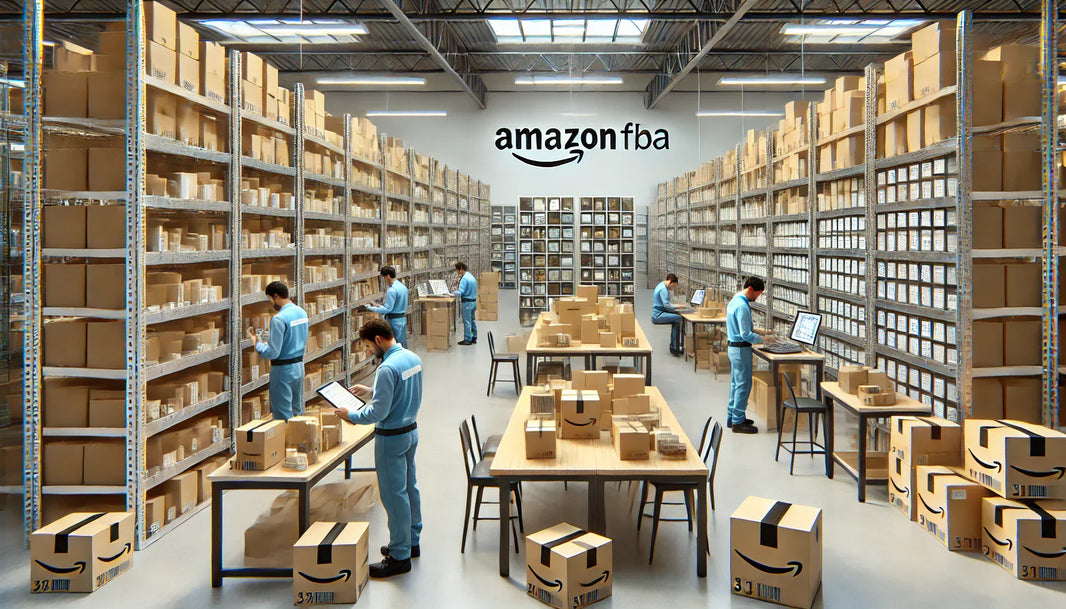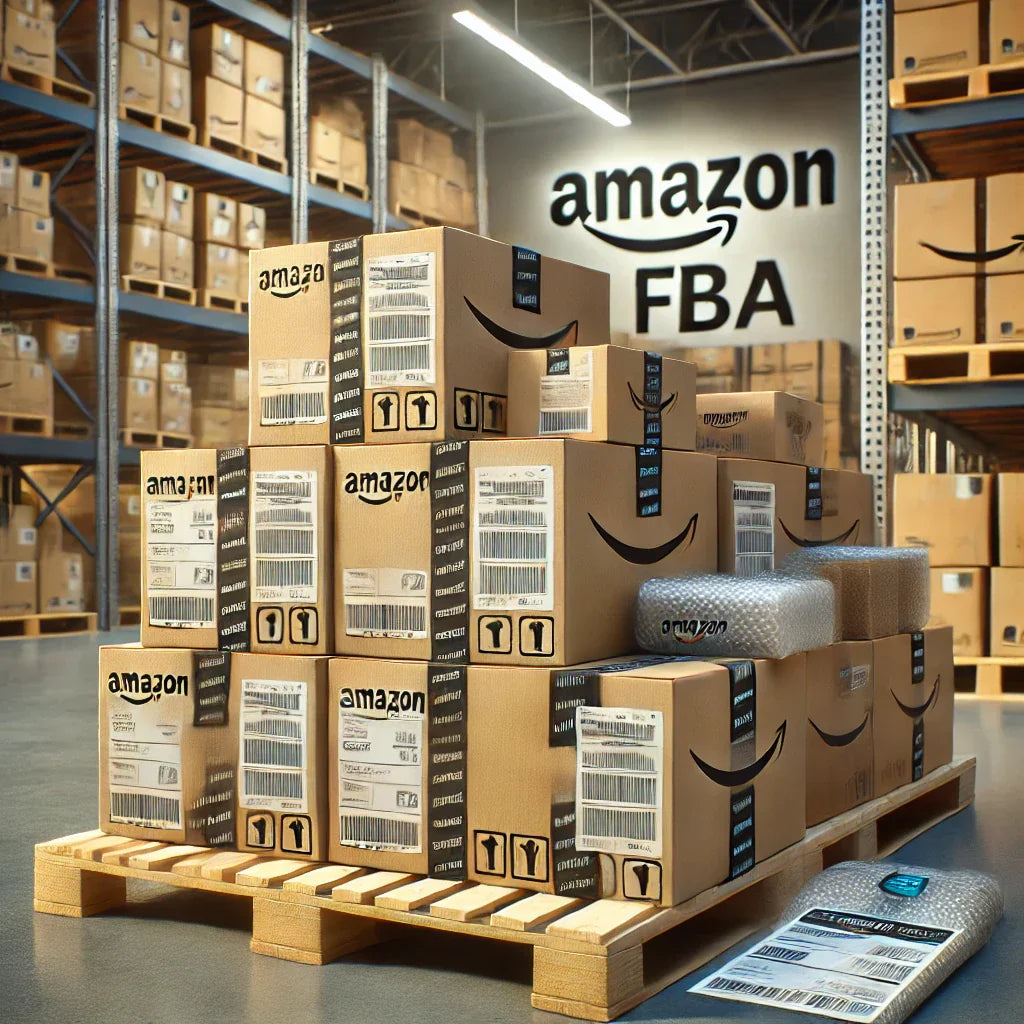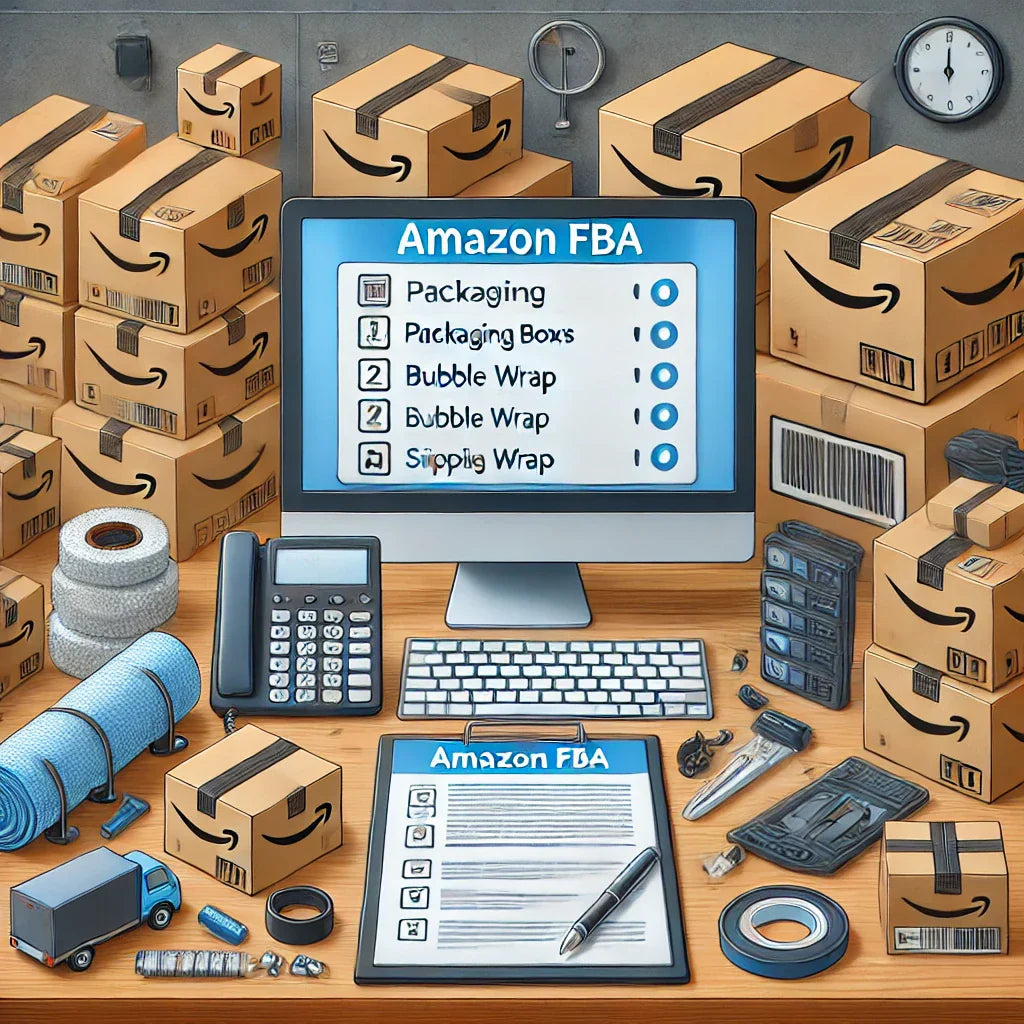Navigating Amazon's inbound prep requirements is crucial for any business aiming to maintain efficient logistics and avoid costly errors. Yet, many sellers encounter common pitfalls in the process, from mislabeling products to overlooking Amazon's stringent packaging standards. These mistakes can lead to unexpected fees, shipping delays, and even product suspensions. This guide covers the most frequent mistakes businesses make during Amazon inbound prep and offers actionable strategies to help avoid these issues, ensuring smooth operations and compliance with Amazon’s guidelines.

1. Misunderstanding Amazon FBA Prep Requirements
Amazon has specific rules and standards for product preparation in its Fulfillment by Amazon (FBA) system. These guidelines dictate everything from packaging materials to labeling requirements. However, one of the most common mistakes new sellers make is not fully understanding these requirements.
Consequence of Misunderstanding Prep Requirements
Failing to meet Amazon’s inbound prep requirements often results in additional fees, product rejection, or delays. In some cases, products that don’t meet the requirements might even be returned to the seller, incurring additional shipping costs.
Solution
To avoid this pitfall, sellers should familiarize themselves with Amazon’s detailed FBA prep requirements. Key areas to review include labeling, barcoding, and packaging materials. For example, fragile items require bubble wrap, and liquids need sealed packaging. Regularly check Amazon’s FBA guidelines, as requirements can change frequently.
2. Inadequate Labeling of Products and Packaging
Proper labeling is essential to the Amazon FBA process, and yet many sellers struggle with this aspect. Labels must be correctly positioned, readable, and scannable. Additionally, Amazon requires specific label formats, such as FN-SKU or UPC codes, depending on the type of product and listing.
Consequences of Inadequate Labeling
Incorrect labeling can lead to inventory misplacement within Amazon’s warehouses, resulting in delays in shipment processing. Inaccurate or missing labels may cause Amazon to re-label products, which incurs additional fees.
Solution
Ensure that each item is accurately labeled according to Amazon’s standards. Invest in high-quality label printers and conduct periodic quality checks to ensure labels are readable and securely attached. Additionally, consider using Amazon’s Label Service, where Amazon handles labeling for an extra fee.
3. Ignoring Amazon’s Packaging Guidelines
Amazon’s packaging requirements vary by product type and are designed to protect items during transit and storage. However, many sellers overlook these guidelines, leading to damaged goods and additional prep fees. For example, Amazon requires that sharp items be wrapped securely and liquids be double-sealed.
Consequences of Ignoring Packaging Guidelines
Improper packaging can result in damaged goods, increasing the risk of returns and negative reviews. Additionally, items that don’t meet Amazon’s packaging requirements may be re-packaged by Amazon, often at a high cost to the seller.
Solution
Review Amazon’s packaging guidelines for each type of product you plan to ship. It’s also beneficial to conduct drop tests to ensure your packaging can withstand transit. Many third-party prep centers specialize in Amazon-compliant packaging and can handle this process for sellers, which can be particularly helpful for new sellers.
4. Overlooking Amazon’s Product Restrictions
Certain items are restricted from FBA due to size, content, or other factors. Unfortunately, many sellers overlook these restrictions, leading to stock rejections or removals.
Consequences of Overlooking Product Restrictions
Sending restricted products can result in penalties, including account suspension. Amazon may also require the seller to remove these items, which incurs additional costs.
Solution
Before shipping any products, carefully review Amazon’s list of restricted items and prohibited products for FBA. Use Amazon’s FBA Revenue Calculator to verify that your items are eligible. Avoid selling items that are restricted or prohibited to minimize the risk of penalties.
5. Underestimating Inventory Forecasting
Accurate inventory forecasting is crucial in avoiding both overstock and stockouts. However, many sellers fail to adequately project their inventory needs, leading to missed sales opportunities and additional storage fees.
Consequences of Poor Inventory Forecasting
Overstock can result in long-term storage fees, while stockouts can lead to missed sales and a decrease in search rankings. Additionally, consistent stockouts can negatively impact your Amazon seller metrics.
Solution
Use Amazon’s inventory forecasting tools or third-party inventory management software to analyze past sales data and plan for future demand. Account for seasonality, product demand trends, and Amazon’s storage limits when forecasting.
6. Neglecting to Perform Quality Control
One of the most common mistakes sellers make is not performing quality control checks before sending products to Amazon warehouses. Poor-quality items or defective units can lead to increased return rates and negative reviews.
Consequences of Poor Quality Control
Failing to check product quality can result in higher return rates and customer dissatisfaction, impacting your seller rating. Additionally, defective products may be removed from Amazon’s warehouses, adding extra costs.
Solution
Establish a quality control process before shipping products to Amazon. Inspect items for defects, damages, and proper functionality. Many third-party prep centers offer quality control services as well.
7. Incorrectly Calculating Prep and Fulfillment Costs
Understanding and calculating prep and fulfillment costs is crucial to pricing products competitively on Amazon. Many sellers underestimate these costs, impacting their profit margins.
Consequences of Incorrect Cost Calculations
Failing to account for all prep and fulfillment costs can result in reduced profit margins, making it difficult to sustain business growth.
Solution
Use Amazon’s FBA fee calculator to estimate the prep and fulfillment costs for each product accurately. Factor in costs for labeling, packaging, and quality control when determining product pricing.
8. Choosing Inadequate Prep Centers
Selecting the right prep center is essential for efficient FBA operations. Many sellers choose prep centers based on location or cost alone, overlooking critical factors like experience and Amazon compliance.
Consequences of Choosing an Inadequate Prep Center
Working with an unqualified prep center can lead to delays, non-compliant packaging, and missed shipments, ultimately impacting customer satisfaction.
Solution
Research and select a prep center with experience in Amazon FBA requirements. Ensure that the prep center is well-versed in Amazon’s packaging, labeling, and quality control standards. Some prep centers offer additional services, like inventory forecasting and quality control, which can further streamline your FBA process.
9. Mismanaging Inventory Placement Settings
Amazon allows sellers to enable or disable Inventory Placement Service (IPS), which affects where products are stored. Many sellers overlook this option, resulting in higher costs and increased complexity in logistics.
Consequences of Mismanaging Inventory Placement
If disabled, Amazon may distribute products across multiple fulfillment centers, leading to increased shipping costs. If enabled, it may increase processing time but reduces the complexity of shipping.
Solution
Analyze your logistics needs and determine if Amazon’s Inventory Placement Service aligns with your budget and time requirements. Sellers shipping large quantities may benefit from using IPS to simplify the process, while others may save costs by manually handling distribution.
10. Failing to Plan for Peak Seasons
Peak seasons, such as holidays, can significantly impact product demand. Many sellers fail to prepare for these peaks, resulting in stockouts, delayed shipments, and lost sales.
Consequences of Poor Seasonal Planning
Insufficient stock during peak seasons leads to missed sales and reduced search rankings, which can negatively impact long-term sales. Additionally, Amazon increases storage fees for FBA inventory during peak times, which can impact costs.
Solution
Use data from previous years to anticipate demand fluctuations during peak seasons. Consider increasing your safety stock levels or adjusting reorder points to meet demand surges.
11. Lack of Compliance with Amazon’s Hazardous Materials Policy
Amazon has strict guidelines regarding hazardous materials, and failing to comply with these requirements can lead to significant issues. Many sellers overlook these policies or incorrectly classify products.
Consequences of Non-compliance with Hazardous Material Policy
Non-compliant products may be rejected, restricted, or returned, leading to increased costs and potential account suspension.
Solution
Ensure that you correctly classify products that fall under Amazon’s hazardous materials category. Amazon provides a Dangerous Goods Identification Guide to assist with compliance. For products with complex regulatory needs, consider consulting a compliance specialist.

12. Ignoring Amazon’s Expiration Date Requirements
For items with expiration dates, Amazon has specific requirements on how dates should be displayed and managed. Failing to comply can lead to product removal or disposal.
Consequences of Ignoring Expiration Date Requirements
Amazon may remove or dispose of products with improperly marked expiration dates. This is especially relevant for products like food, supplements, or beauty items.
Solution
Ensure that all expiration-dated items are labeled with the format “MM-DD-YYYY” and that these products meet Amazon’s freshness requirements. Implement a system to track and rotate inventory based on expiration dates.
13. Improper Handling of Fragile or Perishable Goods
Shipping fragile or perishable items through Amazon requires special attention to avoid damage and ensure compliance with Amazon's quality standards. Sellers often make the mistake of using inadequate packaging materials or shipping these items without sufficient protective measures.
Consequences of Improper Handling
Poorly packaged fragile items are more susceptible to damage during transit, resulting in returns, refunds, and customer dissatisfaction. Similarly, perishable goods require specific packaging to prevent spoilage. Mishandling these items can result in Amazon disposal or customer complaints, both of which negatively affect seller metrics.
Solution
For fragile goods, use extra bubble wrap, sturdy boxes, and cushioning to prevent movement inside the package. Amazon recommends a "6-face protection" for fragile items, which means that every side of the product should be protected from impact. For perishables, consider temperature-regulated packaging to preserve freshness, and ensure that these products comply with Amazon's temperature control policies.
14. Ignoring Amazon’s Storage Limitations and Policies
Amazon places strict limitations on storage space, particularly for new sellers or those with low Inventory Performance Index (IPI) scores. Sellers often overlook these limits, sending in excess inventory that Amazon cannot accommodate, leading to rejection or return of shipments.
Consequences of Overlooking Storage Policies
Ignoring Amazon’s storage policies can result in unexpected fees, forced returns, and even lower storage allocation. High storage fees during peak periods can cut into profit margins, making it essential for sellers to optimize their inventory planning.
Solution
Monitor your Inventory Performance Index (IPI) score and avoid overstocking. Amazon uses the IPI score to assess inventory management efficiency, and a high score can lead to increased storage space allocation. Regularly check your IPI score and adjust your shipment volumes accordingly to prevent penalties. Additionally, consider using third-party storage solutions during peak seasons when Amazon storage fees are higher.
15. Failing to Prepare for Multi-Channel Fulfillment (MCF)
Amazon’s Multi-Channel Fulfillment (MCF) service allows sellers to use their inventory stored in FBA warehouses for orders placed on other platforms, such as eBay or Shopify. However, sellers often neglect to account for this when planning their FBA prep, leading to stockouts or fulfillment issues.
Consequences of Neglecting Multi-Channel Fulfillment Prep
Without considering MCF, sellers may find themselves out of stock on Amazon or other platforms, negatively impacting customer satisfaction. Failing to anticipate multi-channel demand can also lead to inventory imbalance and increased storage fees.
Solution
Analyze sales data across all platforms to forecast demand accurately for each channel. Amazon provides tools within the Seller Central dashboard to help monitor inventory across platforms. Additionally, consider setting up automated alerts for low stock levels to ensure timely replenishment and meet customer demand across all channels.
16. Misinterpreting the Seller-Fulfilled Prime Program Requirements
For sellers participating in the Seller-Fulfilled Prime (SFP) program, understanding and complying with Prime delivery expectations is essential. Many sellers underestimate the level of commitment required to maintain Prime eligibility, especially in terms of delivery speed and handling times.
Consequences of Misinterpreting SFP Requirements
Failing to meet Prime delivery standards can result in lost Prime eligibility, customer complaints, and negative feedback. Inconsistent performance may also affect the visibility of products on Amazon’s platform, as Prime products are often prioritized in search results.
Solution
Ensure that you can consistently meet Prime delivery times and adhere to Amazon’s strict performance metrics. Investing in a reliable carrier or third-party logistics provider that specializes in expedited shipping can help. Regularly track and review delivery metrics within your Amazon dashboard to stay compliant.
17. Underestimating the Importance of SKU Management
Effective SKU management is crucial for optimizing inventory and ensuring accurate listings on Amazon. However, many sellers neglect SKU organization, leading to duplicate listings, misallocated inventory, and inconsistent product data.
Consequences of Poor SKU Management
Mismanaged SKUs can confuse customers and lead to fulfillment errors, such as shipping the wrong product. Duplicate listings may also dilute product reviews and rankings, affecting visibility and sales performance.
Solution
Establish a systematic approach to SKU creation and organization. Use standardized SKU naming conventions that align with your product categories and types, making it easier to track inventory. Consider using inventory management software to streamline SKU tracking and reduce the risk of errors.
18. Overlooking the Need for Product Prep Certification for Certain Categories
Some Amazon categories, such as beauty, supplements, and food items, have specific preparation requirements. Amazon may require sellers in these categories to obtain product prep certifications or submit documentation verifying their compliance with regulatory standards.
Consequences of Overlooking Certification Requirements
Failing to meet certification requirements can lead to product rejections, removals, or account suspensions. Amazon takes consumer safety seriously, particularly for products that require regulatory compliance.
Solution
Familiarize yourself with Amazon’s guidelines for your specific product category. Ensure all necessary certifications, such as food safety or cosmetic labeling standards, are up-to-date and readily available. For complex products, consider consulting with compliance experts to ensure all requirements are met.
19. Disregarding Returns and Reverse Logistics Management
Amazon has stringent policies for handling returns, but sellers often overlook the importance of reverse logistics. This oversight can lead to an accumulation of unsellable inventory or unnecessary costs associated with restocking and reshipping products.
Consequences of Poor Reverse Logistics Management
Failing to plan for returns management can result in inventory build-up, increased storage fees, and a decrease in sellable stock. Unsellable items may end up occupying valuable storage space, which can limit your ability to restock high-demand items.
Solution
Establish a systematic process for handling returns, such as inspecting returned items for damages and labeling them accordingly. Amazon offers an Automated Unfulfillable Removal Service, which can automatically dispose of unsellable items, reducing storage costs. Alternatively, set up a third-party reverse logistics provider to streamline the returns process.
20. Overlooking Local Regulations for International Shipping
Many sellers aim to expand their business internationally by utilizing Amazon’s global shipping network. However, shipping products internationally without understanding the local regulations and import restrictions can result in customs delays, fines, or rejected shipments.
Consequences of Overlooking International Shipping Regulations
Non-compliance with international shipping regulations may lead to costly penalties, confiscated shipments, and delays in reaching customers. Additionally, repeated issues with customs can impact Amazon’s trust in your seller account.
Solution
Research the regulatory landscape of your target international markets, including import tariffs, restricted items, and required documentation. Consider partnering with an international logistics provider that specializes in Amazon FBA to handle customs clearance and compliance on your behalf. Amazon Global Selling also offers resources to assist with international compliance.
21. Neglecting Environmental Sustainability in Packaging
As environmental sustainability gains importance for consumers, Amazon has introduced guidelines encouraging sellers to adopt eco-friendly packaging. Many sellers, however, continue to use excessive or non-recyclable materials, missing an opportunity to reduce costs and appeal to eco-conscious customers.
Consequences of Ignoring Eco-Friendly Packaging
Sellers who overlook sustainable packaging may incur additional costs due to bulkier shipments, waste disposal, and higher material expenses. Moreover, customer dissatisfaction over excessive packaging can lead to negative reviews.
Solution
Opt for sustainable packaging materials like biodegradable packing peanuts, recyclable boxes, and minimal packaging designs. Amazon’s Frustration-Free Packaging program offers guidelines and incentives for sellers who reduce unnecessary packaging, which can improve customer satisfaction and reduce costs.
22. Misunderstanding the Role of Third-Party Logistics (3PL) in the FBA Process
Third-party logistics (3PL) providers can play a valuable role in supporting Amazon FBA sellers by managing product preparation, warehousing, and shipping. However, many sellers misinterpret the role of 3PL providers, leading to inefficiencies and misaligned expectations.
Consequences of Misunderstanding 3PL Capabilities
An unclear understanding of a 3PL provider’s services can lead to delays, increased costs, and issues with compliance. Sellers may assume 3PLs handle all FBA-specific requirements, but not all providers are equipped for Amazon’s stringent prep and labeling standards.
Solution
Clarify expectations and responsibilities with your 3PL provider from the start. Ensure the provider is familiar with Amazon’s prep requirements and can handle FBA-specific needs, including labeling, packaging, and quality control. Regularly communicate with your 3PL provider to streamline operations and prevent misunderstandings.

23. Failing to Keep Up with Amazon Policy Updates
Amazon frequently updates its policies, including those related to FBA prep, returns, and inventory management. Many sellers neglect to stay updated on these changes, resulting in unintentional non-compliance and penalties.
Consequences of Ignoring Policy Updates
Unawareness of policy changes can lead to unintended violations, shipment delays, and even account suspensions. For example, Amazon may modify packaging requirements or add new product restrictions.
Solution
Regularly review Amazon’s updates and communications on Seller Central, and subscribe to Amazon’s email alerts for policy changes. Join Amazon seller communities or forums where updates are discussed, which can help you stay informed about new requirements and trends.
24. Relying Solely on Amazon for Customer Communication
Sellers who do not engage with customers beyond Amazon’s platform may struggle to build brand loyalty. Miscommunication regarding returns, refunds, or product issues can lead to negative reviews and affect seller ratings.
Solution
Although Amazon limits direct communication with customers, you can still take steps to provide excellent customer service within Amazon's policies. For example, use follow-up emails through Amazon's messaging system to thank customers for their purchase and offer guidance on using the product. You can also respond promptly to customer inquiries and address complaints professionally. Additionally, encourage satisfied customers to leave positive feedback and address any negative reviews quickly. By delivering a positive customer experience within the guidelines, sellers can still build a loyal customer base and mitigate the impact of any issues that may arise.
25. Overlooking the Importance of Amazon’s Early Reviewer and Vine Programs
For new products, gathering initial reviews is crucial for building credibility and driving sales. Many sellers overlook Amazon's Early Reviewer Program and Vine Program, both of which help generate early feedback from verified purchasers, giving new listings a competitive edge.
Consequences of Neglecting Review Programs
Without initial reviews, new products often struggle to gain traction on Amazon, as customers tend to choose well-reviewed items. Failing to leverage these programs can lead to slower sales growth, as prospective buyers lack sufficient information to make a purchase decision.
Solution
Consider enrolling eligible products in Amazon’s Early Reviewer and Vine Programs to build trust with new customers. In the Vine Program, Amazon invites trusted reviewers to provide feedback on new products, which can help establish credibility. The Early Reviewer Program, meanwhile, offers incentives to customers who leave honest reviews on new listings. These programs are particularly valuable for new sellers and can accelerate growth by attracting more attention to your products.
26. Neglecting to Optimize Listings with Proper Keywords
Effective product listings are essential for success on Amazon, yet many sellers fail to use optimized keywords that align with customer search behavior. Keyword optimization can significantly impact a product’s visibility in search results and improve sales conversions.
Consequences of Poorly Optimized Listings
Failing to use relevant keywords in product titles, descriptions, and backend fields can lead to lower search visibility, missed sales opportunities, and decreased traffic. In a competitive marketplace, optimized listings are critical to outperforming similar products.
Solution
Conduct keyword research to identify high-traffic, relevant terms and integrate these keywords into your product title, bullet points, and description. Amazon’s own keyword tools, as well as third-party platforms like Helium 10 and Jungle Scout, can help identify popular search terms. Additionally, consider including long-tail keywords that are specific to your product’s unique features or benefits, which can attract more targeted traffic and improve conversion rates.
27. Ignoring Amazon’s “Small and Light” Program for Eligible Products
Amazon’s “Small and Light” program offers reduced fulfillment fees for small, lightweight items, providing cost savings to sellers and often resulting in lower prices for customers. However, many sellers overlook this program, missing an opportunity to increase profitability for eligible products.
Consequences of Overlooking the “Small and Light” Program
By not enrolling eligible items, sellers may incur higher fulfillment costs, which can eat into profit margins and reduce competitiveness. The “Small and Light” program can significantly cut costs, making products more attractive to budget-conscious customers.
Solution
Evaluate your product catalog to determine whether any items qualify for the “Small and Light” program. Eligible products typically weigh less than three pounds and are priced under $12. Enrollment can be completed through Seller Central, and Amazon provides guidance on eligibility and fee reductions associated with this program. For sellers with a wide range of small items, this program can result in considerable savings over time.
28. Failing to Regularly Audit FBA Fee Charges
Amazon charges various fees for FBA services, including fulfillment fees, storage fees, and fees for additional services such as labeling and packaging. Sellers who do not regularly audit these charges may end up paying more than expected, as fees can vary based on seasonality, product size, and storage duration.
Consequences of Overpaying FBA Fees
Over time, inaccurate or unexpected fees can cut into profits and reduce a seller’s ability to invest in inventory or marketing. Seasonal changes in storage fees or discrepancies in product dimensions can also lead to excessive charges.
Solution
Review FBA fee reports in Seller Central regularly to ensure all charges are accurate. Pay special attention to product size and weight, as misclassifications can result in higher-than-necessary fees. Amazon allows sellers to file reimbursement claims if errors are found in FBA charges, so it’s worth verifying these fees periodically to ensure compliance and prevent overcharges.
29. Not Utilizing Amazon Advertising Effectively
Amazon advertising can significantly boost a product’s visibility and sales, yet many sellers fail to leverage its potential, either by not using ads at all or by running ineffective campaigns. Properly structured advertising can improve a product’s ranking, increase brand visibility, and drive conversions.
Consequences of Poor Advertising Strategy
Without advertising, new products struggle to gain initial visibility in Amazon’s search results, leading to slower growth. Running ads without a well-defined strategy can also result in wasted ad spend and low return on investment (ROI).
Solution
Develop a strategic advertising plan that includes Sponsored Products, Sponsored Brands, and Sponsored Display ads, depending on your budget and objectives. Begin with targeted ads on high-performing keywords identified through Amazon’s keyword research tools, and monitor ad performance through Amazon’s Advertising Console. Regularly refine your campaigns to optimize for clicks and conversions, and consider using Amazon’s automated ad targeting for keyword discovery.
30. Overlooking Product Bundling Opportunities
Product bundling allows sellers to combine complementary products into a single offering, often leading to increased average order values and higher customer satisfaction. However, many sellers overlook this opportunity, limiting their ability to stand out in a competitive market.
Consequences of Neglecting Product Bundling
Without bundling, sellers miss the chance to attract customers looking for comprehensive solutions or gift sets. Additionally, bundling can reduce competition by offering a unique combination that isn’t available through other listings.
Solution
Identify products in your catalog that could be bundled together and appeal to a specific customer need. For instance, a skincare brand might bundle a cleanser, toner, and moisturizer, while a camping supply seller could offer a tent, sleeping bag, and lantern set. Amazon allows for custom bundling as long as items are individually labeled, making this a practical and profitable strategy.
31. Failing to Optimize for Mobile Shopping
With a significant portion of Amazon’s traffic coming from mobile users, optimizing listings for mobile devices is essential. However, many sellers design listings solely for desktop, leading to poor mobile user experiences and lower conversions.
Consequences of Ignoring Mobile Optimization
Listings that are difficult to read or navigate on mobile may deter potential buyers, leading to lost sales opportunities. Since mobile commerce is a growing trend, ignoring mobile optimization can reduce a product’s competitiveness.
Solution
Review your listings on a mobile device to assess readability and layout. Shorten bullet points to make key details more scannable, and avoid large blocks of text in product descriptions. High-quality images optimized for mobile display are also essential, as they allow customers to see product details clearly. Amazon’s Enhanced Brand Content (EBC) or A+ Content features are helpful for creating visually appealing, mobile-friendly listings that drive engagement.
32. Disregarding Product Photography Quality
High-quality product photography is a critical factor in driving conversions on Amazon, yet some sellers underestimate its impact. Using low-resolution or poorly composed images can deter potential buyers and limit the effectiveness of your listing.
Consequences of Poor Product Photography
Listings with subpar images often struggle to convert, as customers rely heavily on visual information to make purchasing decisions. Poor photography can lead to lower click-through rates (CTR) and higher bounce rates.
Solution
Invest in professional photography for your product images. Follow Amazon’s image requirements, including white backgrounds, clear lighting, and high-resolution shots. Incorporate lifestyle images to show the product in real-world scenarios and highlight key features from multiple angles. A well-presented image set can significantly increase customer confidence and improve conversion rates.
33. Lack of Regular Inventory Health Audits
Effective inventory management extends beyond just stocking and shipping products. Sellers need to conduct regular health audits of their inventory, assessing factors like aging stock, unsellable items, and storage optimization. Many sellers overlook this, leading to excess storage costs, inefficient stocking, and potential sales losses.
Consequences of Neglecting Inventory Health Audits
Without regular audits, inventory can accumulate, especially during off-peak seasons, leading to unnecessary storage fees. Aging stock may also go unnoticed, particularly for items with expiration dates or seasonality, resulting in waste and lower profit margins.
Solution
Conduct inventory health audits quarterly or monthly to evaluate the movement of each SKU. Amazon provides inventory health reports in Seller Central that include details such as excess inventory, aging inventory, and recommended removal dates. Use these insights to make data-driven decisions, such as replenishing high-demand items or reducing prices to clear aging stock.

34. Overlooking Amazon’s Inventory Placement Service (IPS) Cost-Saving Opportunities
Amazon’s Inventory Placement Service (IPS) offers an option for sellers to ship their inventory to a single fulfillment center, after which Amazon redistributes it to various locations. While many sellers use IPS for convenience, others are unaware of how strategic IPS use can lead to cost savings, especially for smaller or lighter products.
Consequences of Ignoring IPS for Cost Optimization
Using standard distribution without analyzing costs may lead to higher shipping expenses and lower profitability, particularly for small sellers or those managing multiple SKUs.
Solution
Assess the costs associated with using IPS versus regular fulfillment center shipments. In certain cases, IPS can reduce shipping costs, simplify logistics, and improve delivery times. For low-margin or lightweight items, IPS can provide significant cost savings, especially if you ship large volumes. By strategically applying IPS to specific products, sellers can cut down on unnecessary shipping expenses while optimizing their distribution network.
35. Misunderstanding Amazon’s Small Parcel Delivery (SPD) and Less Than Truckload (LTL) Freight Options
For inbound shipments to Amazon’s fulfillment centers, sellers can choose between Small Parcel Delivery (SPD) and Less Than Truckload (LTL) freight. Many sellers don’t fully understand the cost and logistical differences between these options, leading to missed savings opportunities and inefficient shipping.
Consequences of Choosing the Wrong Shipping Option
Choosing SPD for large shipments may lead to higher per-unit shipping costs, while opting for LTL without full truckload considerations can lead to delays, higher costs, and potential mishandling of products.
Solution
Evaluate your shipment size, frequency, and budget to choose the most cost-effective method. For larger shipments, LTL can reduce costs per unit, especially when shipping high-volume, non-urgent inventory. SPD is better suited for smaller shipments that need quick replenishment. Additionally, using a third-party freight provider who specializes in Amazon’s requirements can streamline the LTL process and provide a more consistent experience.
36. Failing to Prepare for Seasonal Inventory Management
Seasonal demand fluctuations, particularly during holidays, pose unique challenges for Amazon sellers. Failing to adjust inventory levels and inbound prep procedures for peak seasons can result in stockouts, overstock, and missed sales opportunities.
Consequences of Poor Seasonal Inventory Planning
Underestimating holiday demand or peak season surges can lead to stockouts, negatively affecting search rankings and customer satisfaction. Overstocking, on the other hand, can result in excessive long-term storage fees, which are often higher during peak periods.
Solution
Review historical sales data, industry trends, and Amazon’s seasonal recommendations to forecast demand accurately. Adjust safety stock levels, reorder points, and prep processes to accommodate these fluctuations. To avoid high storage costs, consider storing excess inventory with a third-party logistics provider until needed for replenishment. For new products, estimate seasonal demand based on similar products or industry data.
37. Neglecting the Importance of Product Variation Management
Amazon sellers with multiple variations of the same product, such as different colors or sizes, often face challenges in managing these variations. Without an effective system, sellers risk inventory imbalances, listing confusion, and fulfillment errors.
Consequences of Poor Variation Management
Mismanaging product variations can lead to stockouts of certain options while other variations sit unsold. Additionally, poorly organized variations can confuse customers and reduce the likelihood of conversions.
Solution
Organize product variations under a single listing using Amazon’s parent-child SKU structure. This setup allows customers to see all available options in one place, making it easier to select their preferred variation. Inventory management software that tracks individual variations can also help monitor stock levels, sales trends, and demand patterns, ensuring that each variation is adequately stocked.
38. Disregarding Amazon’s Prep Requirements for Oversized and Heavy Items
Shipping oversized and heavy items requires specific packaging and handling procedures, which many sellers overlook. Amazon has unique guidelines for these products to ensure they can be safely and efficiently transported and stored.
Consequences of Ignoring Oversized Item Prep Requirements
Non-compliance with Amazon’s guidelines for oversized items can result in product damage, customer complaints, and added fees for repackaging or handling. These issues can negatively impact your seller performance metrics.
Solution
Review Amazon’s requirements for oversized products, which include reinforced packaging, additional padding, and clear labeling for heavy items. Amazon’s oversized item guidelines also include dimension thresholds, so measure each product accurately. Ensure you have the appropriate materials, such as durable boxes and palletization when necessary, to comply with these guidelines and avoid additional fees.
39. Mismanagement of Lead Times in Supply Chain Planning
Understanding and accurately estimating lead times is essential for keeping inventory levels consistent. Sellers who mismanage lead times often face stockouts or excess inventory, as they are unable to accurately predict when new inventory will arrive at Amazon’s fulfillment centers.
Consequences of Poor Lead Time Management
Without reliable lead time tracking, sellers risk frequent stockouts, negatively impacting sales rank and customer satisfaction. Conversely, overestimating lead times can lead to overstock, incurring additional storage fees.
Solution
Track lead times for each supplier and product to improve inventory forecasting. Use historical data to estimate the average time it takes for products to move through each stage, from manufacturing to fulfillment center arrival. Consider adding a buffer period to accommodate potential delays, especially for high-demand or seasonal items. Inventory management software can help by automatically tracking lead times and adjusting reorder points accordingly.
40. Underutilizing Amazon’s Reporting and Analytics Tools
Amazon provides sellers with a range of reports and analytics tools in Seller Central, including Inventory Health Reports, Restock Inventory, and the Sales Dashboard. Many sellers fail to leverage these tools fully, missing out on valuable insights for managing their FBA prep and inventory.
Consequences of Ignoring Amazon’s Data Tools
Without data-driven insights, sellers may face difficulties in optimizing their inventory and inbound prep processes. This oversight can lead to inefficient inventory levels, missed sales opportunities, and higher storage costs.
Solution
Regularly review Amazon’s available reports, such as Inventory Health and Restock Inventory, to gain insights into demand trends, inventory performance, and stock requirements. Amazon also offers forecasting tools that help predict future demand and suggest restock quantities based on sales data. Use this information to refine inventory planning, improve lead times, and align inbound prep activities with actual demand.
41. Misjudging the Impact of Amazon’s Storage Fees and Overhead Costs
Amazon FBA storage fees fluctuate based on seasonality, inventory age, and the type of storage used. Many sellers overlook these variable costs when managing their FBA prep, leading to unexpected expenses and reduced profitability.
Consequences of Misjudging Storage Fees
Failing to account for long-term and peak season storage fees can significantly reduce profit margins. If products are left unsold in Amazon warehouses, these fees can add up quickly, impacting cash flow and overall profitability.
Solution
Review Amazon’s FBA storage fee structure to understand how fees are calculated based on volume and storage duration. Implement strategies to reduce long-term storage costs, such as timely reordering, improved inventory turnover, and liquidation of slow-moving stock. If fees become excessive, consider offloading excess inventory to a third-party storage provider or using Amazon’s Automated Removal Setting to remove unsellable items from FBA warehouses.
42. Failing to Take Advantage of Amazon’s Automated Pricing Tool
Amazon’s Automated Pricing tool allows sellers to adjust prices dynamically based on competitors’ listings, helping to maintain competitiveness and improve chances of winning the Buy Box. Sellers who do not use this tool may struggle with price management, especially in competitive categories.
Consequences of Inconsistent Pricing
Without automated pricing adjustments, products may be priced too high or too low, either leading to lost sales or lower profit margins. Manually adjusting prices is time-consuming and can result in missed opportunities.
Solution
Set up Amazon’s Automated Pricing tool with specific rules that align with your pricing strategy. Choose rules that help keep your products competitive without undercutting too drastically, as frequent price drops can impact brand perception. Additionally, monitor the performance of these pricing rules periodically to ensure they continue to meet your revenue and margin goals effectively.

Conclusion
Amazon’s inbound prep process may seem complex, but by avoiding these common mistakes, sellers can ensure smooth and cost-effective operations. Missteps in labeling, packaging, inventory forecasting, and compliance with Amazon’s specific guidelines can lead to costly delays, fees, and negative customer experiences. By implementing robust processes for quality control, choosing qualified prep centers, and understanding Amazon’s requirements, sellers can mitigate these risks, maximize efficiency, and focus on growing their Amazon business confidently.
Read More
- The Essential Guide to Inbound Prep for Amazon Sellers
- How to Optimize Inbound Prep for Amazon: Best Practices and Tips
- Understanding Amazon's Inbound Prep Requirements: A Step-by-Step Guide
- Inbound Prep Services for Amazon FBA: What Sellers Need to Know
- Amazon Inbound Prep: Streamlining Your Process for Faster Fulfillment
- Why Inbound Prep is Crucial for Amazon Success: An Overview for Sellers







